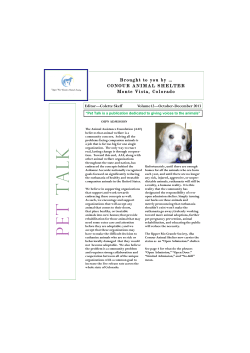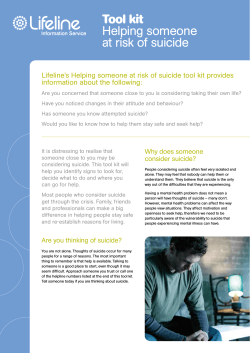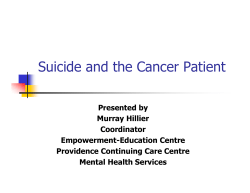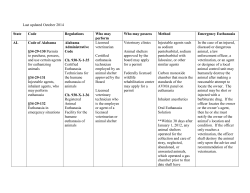
SUPREME COURT OF CANADA TO DETERMINE OCTOBER 15, 2014
SUPREME COURT OF CANADA TO DETERMINE LEGALIZATION OF ASSISTED SUICIDE AND EUTHANASIA IN CANADA OCTOBER 15, 2014 AN URGENT NEED FOR NATIONAL PRAYER On October 15, 2014, the Supreme Court of Canada is set to hear the Carter vs Canada Case that seeks to legalize assisted suicide and euthanasia in Canada. Definitions of terms (used according to the BC Court of Appeal summary for Carter vs Canada 20131): The definitions differentiate between the concepts of “physician-assisted suicide,” and “euthanasia.” Physician-assisted suicide involves intentionally killing oneself where a physician, or someone under the direction of a physician, provides the knowledge, means, or both to assist in the suicide. The patient, however, performs the act which causes death. Euthanasia occurs where the physician performs the act which leads to death. Euthanasia may be voluntary, non-voluntary, or involuntary. Physician-assisted dying is a term which covers both physician-assisted suicide and voluntary euthanasia. BACKGROUND INFORMATION On June 15, 2012, Justice Lynn Smith, a British Columbia Supreme Court judge, ruled in favour of assisted suicide and euthanasia in the Carter Case2 by ruling that exceptions should be made to the Criminal Code (particularly sec. 241)3 that prohibits counseling or assisting someone to commit suicide. The Federal Government appealed this decision, and the BC Court of Appeal, in a 2-1 decision, overturned this ruling in October 20134. The plaintiffs in the Carter case are now appealing to the Supreme Court of Canada to restore the original ruling in favour of physician-assisted suicide and euthanasia. The case will be heard on Oct. 15, 2014. The plaintiffs have asserted (like Quebec in Bill 52/An Act Respecting End-of-Life Care) that euthanasia and assisted suicide are matters relating to health care, and thus are under the exclusive jurisdiction of the provinces5,6. The passage Bill 52/An Act Respecting End-of-Life Care on June 5, 2014 legalized euthanasia in the province of Quebec, however the constitutionality of this Act is being challenged by grassroots organizations7,8,9,10. IMPLICATIONS OF THE CARTER CASE The Supreme Court of Canada could uphold our current laws and state that assisted dying is not health care. Alternatively, the Supreme Court of Canada could reject the decision by Justice Smith but assert that euthanasia can be defined as a form of health care. The Supreme Court of Canada could conceivably decide on both the Carter case in BC and the constitutionality of the Quebec euthanasia law at the same time. If the Supreme Court of Canada upholds the original BC Supreme Court judgment (in favour of euthanasia and assisted suicide), this will fundamentally change Canadian law to allow for legalized euthanasia and assisted suicide. p. 1 of 4 The implications of changing the law to allow euthanasia and assisted suicide would be a monumental shift in societal values and attitudes. The outcome would have a direct impact upon the medical profession and how patient care is delivered, putting at risk the lives of many Canadians. Concerning Developments at the Canadian Medical Association (CMA) General Council Meeting on End-of-Life Issues, August 19, 2014 Euthanasia and assisted suicide have been legal in the Netherlands since 2002. The Dutch model has often been touted by euthanasia proponents to be the ideal model for the administration of euthanasia/physician-assisted suicide. At the recent 2014 Canadian Medical Association (CMA) General Council meeting on End-ofLife Issues, attendees at the General Council meeting were led to believe that there was no such thing as a “slippery slope” in the implementation of legalized euthanasia/physician-assisted suicide in the Netherlands. (See endnote [11] below to watch full webcast of the CMA session). Of grave concern was the absence of any representative from the Netherlands to present a dissenting perspective. The assertion made that there is “no slippery slope” in the Netherlands regarding euthanasia is false. Dutch Ethicist Theo Boer’s published commentary highlights the troubling developments in the Netherlands that led him to retract his initial support for the legalization of euthanasia and assisted suicide. Please read Mr. Boer’s complete text below12. His words reveal disturbing truths of which we must be aware; we as a nation would do well to heed his warning. Somerville and Boudreau (2014) similarly document that in the Netherlands euthanasia “has been extended to include people with mental, but not physical, illness, as well as to newborns with disabilities and older children.” 13 The slippery slope also exists in other jurisdictions where euthanasia is legal. “In Belgium, euthanasia has recently been extended to children, it is being considered whether to do the same for people with dementia, and organs are being taken from euthanized people for transplantation. The logical and practical slippery slopes are unavoidable because once we cross the clear line that we must not intentionally kill another human being, there is no logical stopping point.”14 Unfortunately, CMA physician delegates were not made aware of these developments in the Netherlands. When even leaders in the medical profession are presented with misinformation on these issues, it is all the more important that we make every effort to inform ourselves on these issues and strive to understand the very serious consequences that we shall face if euthanasia and assisted suicide become legal in Canada. _____________________________________________________________________ p. 2 of 4 USEFUL INFORMATION/ARTICLES • • • • PowerPoint Teaching Tool Opposing Physician-Assisted Suicide/Euthanasia (PAS/E) Christian Medical and Dental Society (CMDS) http://www.cmdscanada.org/ Commentary: The wrong decision on assisted suicide. Will Johnston (2012). http://alexschadenberg.blogspot.ca/2012/06/wrong-decision-on-assisted-suicide.html Euthanasia and Assisted Suicide: A Physician’s and Ethicist’s Perspectives. Somerville and Boudreau (2014). Medicolegal and Bioethics 2014:4 1-12 http://www.dovepress.com/euthanasia-and-assisted-suicide-a-physicianrsquos-andethicistrsquos-p-peer-reviewed-article-MB Commentary: “Assisted Dying – Don’t Go There”. Dutch Ethicist Theo Boer (2014) http://www.dailymail.co.uk/news/article-2686711/Dont-make-mistake-As-assistedsuicide-bill-goes-Lords-Dutch-regulator-backed-euthanasia-warns-Britain-leads-masskilling.html#ixzz3Cf7d1fNL BACKGROUND COURT DECISION DOCUMENTS • • • British Columbia Court of Appeal, Carter v. Canada (Attorney General), 201315 British Columbia Supreme Court, Carter v. Canada (Attorney General), 201216 Supreme Court of Canada, Rodriguez v. British Columbia (Attorney General), 199317 Endnotes: 1 [Paragraph 13: http://www.courts.gov.bc.ca/jdb-‐txt/CA/13/04/2013BCCA0435.htm] 2 Legalizing therapeutic homicide and assisted suicide – A Tour of Carter vs Canada. By Sean Murphy, Protection of Conscience Project <http://www.consciencelaws.org/law/commentary/legal073-001.aspx#Abstract> 3 http://laws-lois.justice.gc.ca/eng/acts/C-46/page-119.html#docCont 4 Carter v. Attorney General for British Columbia: Physician-‐assisted suicide. By Arthur Grant. The Canadian Bar Association. http://www.cba.org/CBA/sections_consthr/news2014/PrintHTML.aspx?DocId=54163 5 http://www.consciencelaws.org/archive/documents/carter/2011-04-26-noticeofclaim01.pdf (Part 3, Par 2). “The treatment and management of the physical and emotional suffering of a grievously and irremediably ill patient and, in particular, the determination of capability and consent for purposes of physician-assisted dying to end that suffering, are matters relating to health care, the regulation and delivery of health services, the practice of medicine, and regulation of the patient-physician relationship. These are matters within the exclusive jurisdiction of the Province of British Columbia on the basis of ss. 92(7), (13) and (16), or any combination thereof, of the Constitution Act, 1867.” 6 Carter Case Appellants’ Factum [par 40-‐53] http://www.scc-‐csc.gc.ca/factums-‐memoires/35591/FM010_Appellants_Lee-‐Carter-‐et-‐al.pdf 7 The Evangelical Fellowship of Canada Analysis: Quebec’s Bill 52: Euphemisms for Euthanasia http://files.efc-‐ canada.net/si/Euthanasia/Quebec's_Bill_52_-‐_Euphemisms_for_Euthanasia.pdf 8 Text of Quebec’s Bill 52/An Act Respecting End-of-Life Care: <http://www.consciencelaws.org/archive/documents/201406-05-bill-52.pdf> 9 Redefining the Practice of Medicine – Euthanasia in Quebec An Act Respecting End-of-Life Care: Legal Commentary <http://www.consciencelaws.org/law/commentary/legal068-001.aspx> 10 http://www.catholicregister.org/item/18300-‐fight-‐is-‐on-‐as-‐quebec-‐s-‐euthanasia-‐bill-‐passes 11 CMA webcast – General Council Meeting on End of Life Issues August 19, 2014. https://webcasts.welcome2theshow.com/cma2014/end-of-life> (Mr. Eric van Wijlick “No slippery slope” at 32min 10s – 32 min 38s). 12 'ASSISTED DYING: DON'T GO THERE': DUTCH ETHICIST THEO BOER In 2001 The Netherlands was the first country in the world to legalise euthanasia and, along with it, assisted suicide. Various ‘safeguards’ were put in place to show who should qualify and doctors acting in accordance with these ‘safeguards’ would not be prosecuted. Because each case is unique, five regional review committees were installed to assess every case and to decide whether it complied with the law. For five years after the law became effective, such physician-induced deaths remained level - and even fell in some years. In 2007 I wrote that ‘there doesn’t need to be a slippery slope when it comes to euthanasia. A good euthanasia law, in combination with the euthanasia review procedure, provides the p. 3 of 4 warrants for a stable and relatively low number of euthanasia.’ Most of my colleagues drew the same conclusion. But we were wrong - terribly wrong, in fact. In hindsight, the stabilisation in the numbers was just a temporary pause. Beginning in 2008, the numbers of these deaths show an increase of 15% annually, year after year. The annual report of the committees for 2012 recorded 4,188 cases (compared with 1,882 in 2002). 2013 saw a continuation of this trend and I expect the 6,000 line to be crossed this year or the next. Euthanasia is on the way to become a ‘default’ mode of dying for cancer patients. Alongside this escalation other developments have taken place. Under the name ‘End of Life Clinic,’ the Dutch Right to Die Society NVVE founded a network of travelling euthanizing doctors. Whereas the law presupposes (but does not require) an established doctor-patient relationship, in which death might be the end of a period of treatment and interaction, doctors of the End of Life Clinic have only two options: administer life-ending drugs or send the patient away. On average, these physicians see a patient three times before administering drugs to end their life. Hundreds of cases were conducted by the End of Life Clinic. The NVVE shows no signs of being satisfied even with these developments. They will not rest until a lethal pill is made available to anyone over 70 years who wishes to die. Some slopes truly are slippery. Other developments include a shift in the type of patients who receive these ‘treatments’. Whereas in the first years after 2002 hardly any patients with psychiatric illnesses or dementia appear in reports, these numbers are now sharply on the rise. Cases have been reported in which a large part of the suffering of those given euthanasia or assisted suicide consisted in being aged, lonely or bereaved. Some of these patients could have lived for years or decades. Whereas the law sees assisted suicide and euthanasia as an exception, public opinion is shifting towards considering them rights, with corresponding duties on doctors to act. A law that is now in the making obliges doctors who refuse to administer euthanasia to refer their patients to a ‘willing’ colleague. Pressure on doctors to conform to patients’ (or in some cases relatives’) wishes can be intense. Pressure from relatives, in combination with a patient’s concern for their wellbeing, is in some cases an important factor behind a euthanasia request. Not even the Review Committees, despite hard and conscientious work, have been able to halt these developments. I used to be a supporter of the Dutch law. But now, with twelve years of experience, I take a very different view. At the very least, wait for an honest and intellectually satisfying analysis of the reasons behind the explosive increase in the numbers. Is it because the law should have had better safeguards? Or is it because the mere existence of such a law is an invitation to see assisted suicide and euthanasia as a normality instead of a last resort? Before those questions are answered, don’t go there. Once the genie is out of the bottle, it is not likely to ever go back in again. Theo Boer has been a Member of a Regional Review Committee since 2005. For the Dutch Government, five such committees assess whether a euthanasia case was conducted in accordance with the Law. In the past nine years, Prof. Boer has reviewed almost 4,000 euthanasia cases. The views expressed here represent his views as a professional ethicist, not of any institution. Read more: http://www.dailymail.co.uk/news/article-2686711/Dont-make-mistake-As-assisted-suicide-billgoes-Lords-Dutch-regulator-backed-euthanasia-warns-Britain-leads-mass-killing.html#ixzz3Cf7d1fNL Alex’s commentary: http://alexschadenberg.blogspot.ca/2014/07/dutch-‐professor-‐now-‐opposes-‐ euthanasia.html ______________________________________________________________________________________________________________________________ Somerville and Boudreau, 2014. Euthanasia and Assisted Suicide: a Physician’s and ethicist’s perspectives. Medicolegal and Bioethics 2014:4 1-12 14 Somerville and Boudreau, 2014. Euthanasia and Assisted Suicide: a Physician’s and ethicist’s perspectives. Medicolegal and Bioethics 2014:4 1-12 15 Carter vs Canada 2013 <http://www.courts.gov.bc.ca/jdb-txt/CA/13/04/2013BCCA0435.htm> 16 Carter vs Canada 2012 <http://www.canlii.org/en/bc/bcsc/doc/2012/2012bcsc886/2012bcsc886.pdf> 17 Rodriguez vs British Columbia 1993 <http://scc-csc.lexum.com/scc-csc/scc-csc/en/1054/1/document.do> 13 p. 4 of 4
© Copyright 2025















